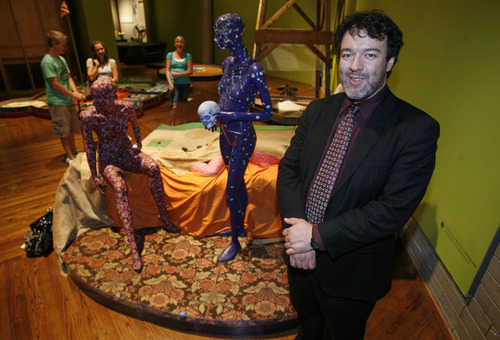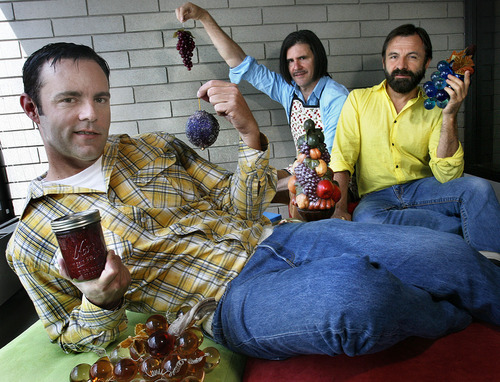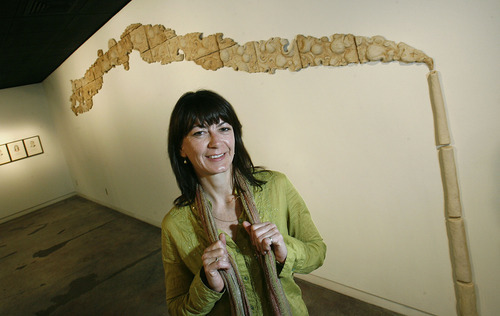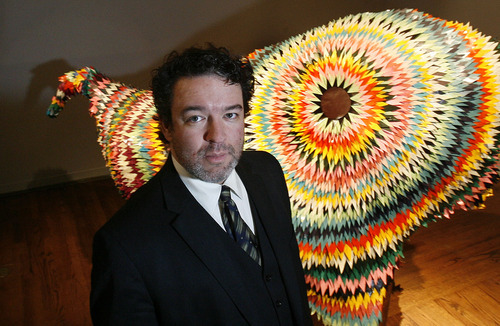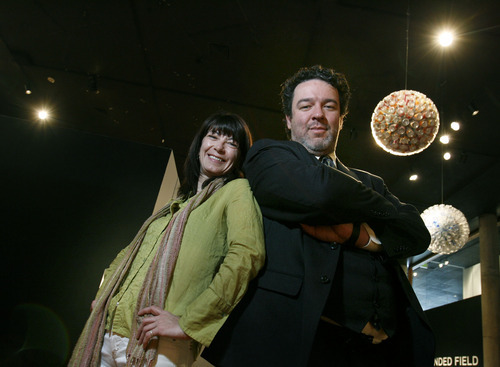This is an archived article that was published on sltrib.com in 2011, and information in the article may be outdated. It is provided only for personal research purposes and may not be reprinted.
A young woman recognized Adam Price, the director of Salt Lake Art Center, at the city's Main Library last fall. She stopped him and pulled out her cellphone.
"She showed me the wallpaper on her phone," Price says. "It was a picture from the 337 Project that she keeps with her to remind her of that experience. She must have only been 14 or 15 at the time, but she keeps that picture."
Five years on, Price's 337 Project remains a watershed event in Utah's contemporary art scene. Price, then a lawyer, turned over a 42-room office building at 337 South 400 East that he owns with his wife, Dessi, to 150 local artists in 2006. The art mob that swarmed over the building ranged from taggers to established gallery artists.
Before the building was ultimately demolished in 2008 — its destruction was integral to the project's vision — 10,000 visitors had toured it. Salt Lake City artists and art lovers still evoke 337 when discussing the growth of Utah's contemporary art scene.
"To have that kind of impact on people with the visual arts is the highest goal for me," Price says. "There was something about watching 337 impact the community — the excitement it generated. If contemporary art is done right and made accessible to enough people, it can completely change the way a city feels about itself. "
—
Opening the doors of the artistic temple • Since then, 42-year-old Price has taken control of the only museum in Salt Lake City committed entirely to contemporary art. And for the past 18 months, he has been applying the lessons of 337 to the nonprofit Salt Lake Art Center to keep it from being a "foreboding temple of art where only acolytes are welcome."
And Price, an art establishment outsider, may be onto something: The museum has more than tripled its attendance — from 20,000 annually to nearly 70,000 — since he arrived.
After less than 18 months, Price's drive to reach out to the community through projects such as artist-designed miniature golf and a "yard art extravaganza," is only the beginning.
"Adam clearly brought creativity and ingenuity from the 337 Project," says Josh Kanter, an Art Center board member for the past eight years. "He brought imagination on how to make an art center relevant to Salt Lake City."
And making something as subversive as contemporary art, with its often ambiguous meanings and complex questions, meaningful to a broader Utah audience is a difficult challenge.
"Contemporary art isn't easy the first time you see it," Kanter says. "You have to make it accessible and fun. Adam's focus has been on, 'How do I get people to care about what we are doing?' "
Price, like other contemporary arts gallery owners, curators and artists, finds Utah to be a hard sell for cutting-edge visual art, even though the culture has been historically welcoming to music, theater and dance. "From the beginning there has been this involvement with the performing arts that hasn't been mirrored in the visual arts," he says.
—
'Why can't we do that?' • Price grew up in Washington, D.C., where he regularly was exposed to art by his art collector mother, Lora. "There was a lot of art around the house and she dragged me as a kid to every museum and art opening in the city — whether I wanted to go or not. In many ways, visual arts is like an old and familiar friend to me."
But Price drifted away from art for many years while he pursued a law degree at Harvard University. He served a clerkship for U.S. District Judge Tena Campbell in Utah in 1996. Two years later he moved back to Boston, but realized Salt Lake City was where he wanted to practice. "I moved back in 2000 and I've been here ever since."
Then came 337. "That project changed people's lives," says Price, and one of those lives was his own. "The 337 Project reminded me what a magical and transformative experience visual art can be."
When the project ended, Price joined the board of Salt Lake Art Center, which under then director Ric Collier had worked closely with the 337 Project. After Collier left the Art Center, Price abandoned his law practice with Jones, Waldo, Holbrook & McDonough to become director in 2009, taking full control in January 2010.
Kanter admits that asking a lawyer to run an art museum might sound disastrous, but it has worked. "Adam is not from the art field, which could be a disadvantage," Kanter says. "The advantage is that he does not know what can't be done. Adam always says, 'Why can't we do that?' I think that's great."
—
Filling the gaps • One of Price's first decisions as director was to hire a senior curator. He chose Micol Hebron, a Los Angeles video and performance artist and a professor at Chapman University in Orange, Calif. Price and Hebron differ in many ways, but they agree that contemporary art must break free of the museum and engage the community.
"Adam has reignited interest in the center and in what contemporary art can be," she says. "It's important that we have different viewpoints. He's a populist and he wants to get as many people in as he can. I want to get as many people as possible, but have them engaged. So I'm willing to do a show that will seem strange or less populist — if we get to introduce an idea that hasn't been here before."
Nevertheless, Hebron accepts the realities of running a nonprofit museum, struggling to balance high attendance with edgy art.
"In a way, people are voting every time they come here," she says. "They are voting as to whether or not they support what we are doing. Because if they don't come, we are not going to be able to continue."
—
Promoting 'risk taking' in Utah • Hebron says she wants Utah artists and the public to join in the global conversation on contemporary art by bringing in cutting-edge exhibits from out of state. "Sometimes that gets misperceived as us being elites or somehow being exclusionary," she acknowledges.
The Art Center has to support local artists, she says, "but we have an obligation and an interest in engaging the public in a conversation about what is characterizing contemporary art today — outside of Salt Lake City, outside of Utah and all over."
"There needs to be a little more risk taking on the part of the contemporary art scene," Hebron says. "When I talk about risk taking, people often think I'm encouraging some brash retaliatory or anarchistic gesture, and that's not the case. I'm more interested in seeing artists move beyond the idea of art as a skill to be perfected and into the idea of concept as the skill they should be exploring."
—
Beyond cultural conservatism • Kanter says Price's lack of academic art credentials and pretenses makes the center more welcoming to a broader public.
"Adam knows what he doesn't know — that's an outstanding attribute in a leader. He's created this dynamic, enthusiastic group around him that fills his knowledge gaps."
As part of that openness, Price refuses to see Utah's cultural and political conservatism as a hurdle to appreciation of contemporary art and the difficult questions it raises.
"It's a matter of opening dialogue in a respectful manner that starts where people are," Price says. "Then offer more and more opportunities to engage with a broader world and see how magical this planet and the people who live on it can be. I don't think that's a liberal or conservative thing."
twitter.com: gwarchol
facebook.com/tribremix —
Salt Lake Art Center to debut populist projects
Upcoming populist arts projects:
• Lawn Gnomes Eat Your Hearts Out will offer tours of lawn art in Salt Lake City. More information at http://www.slartcenter.org/?page_id=249
• Fallen Fruit Utah, a quirky multimedia event, will explore the cultural, historic and artistic impact of fruit on the state. More information at http://www.slartcenter.org/?page_id=927


